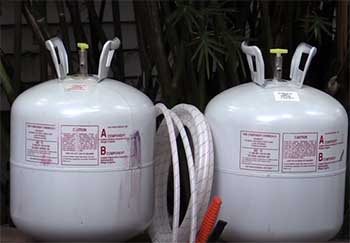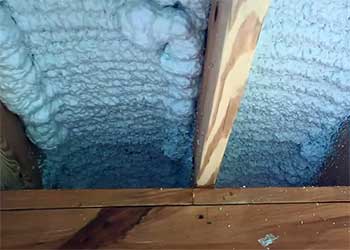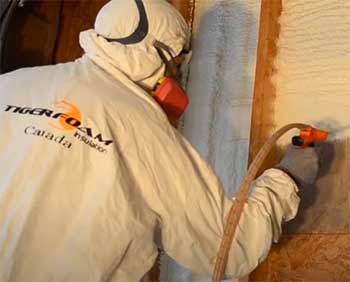Spray foam insulation is becoming an increasingly popular option for insulating homes and commercial buildings. Two of the top brands on the market are Tiger Foam and Foam It Green.
But which one is better?
In this comprehensive guide, we’ll compare Tiger Foam and Foam It Green on key factors like insulation performance, environmental impact, application, and cost to help you decide which spray foam insulation is right for your project.
A Brief Comparison Table
| Aspects | Tiger Foam | Foam It Green |
| Insulation Value | R-6 to R-7 per inch | R-6 to R-7 per inch |
| Formula | Non-toxic, water-blown using soybean oils | Petroleum-based chemicals |
| Environmental Impact | Low VOC, low carbon footprint | Higher VOCs, higher carbon footprint |
| Odor | Minimal odor during and after application | Noticeable VOC odors |
| Cost | 20-30% higher than Foam It Green | Lower cost import |
| Availability | Nationwide distribution network | Limited availability outside coasts |
| Warranty | 10 year thermal, 10 year material | 5 year thermal, 10 year material |
Overview of Tiger Foam and Foam It Green

Tiger Foam and Foam It Green are both closed-cell spray polyurethane foams (SPF).
This means they expand and harden quickly to create a rigid foam layer that fully adheres to the surfaces it’s applied to.
Closed-cell SPF has a high R-value per inch, typically around R-6.5.
It provides excellent insulation, air sealing, and moisture control.
The main differences between the two brands come down to their chemical formulations and manufacturing processes.
Tiger Foam utilizes a non-toxic, water-blown formula made using natural soybean oils. Foam It Green uses a more traditional petroleum-based chemical formula.
Tiger Foam’s products are manufactured in the USA while some Foam It Green products are imported.
Key Differences Between Tiger Foam And Foam It Green Insulation
Now let’s take a detailed look at how Tiger Foam and Foam It Green compare across several key factors:
- Insulation Performance
When it comes to basic thermal insulation, both Tiger Foam and Foam It Green deliver excellent performance. As closed-cell SPF products, they share similar R-values around R-6 to R-7 per inch. This outpaces other types of insulation like fiberglass (R-3 per inch).
The rigid structure of closed-cell SPF means there are virtually no gaps or air pockets. This maximizes the insulation value while also reducing air leakage.
Tiger Foam and Foam It Green will both provide a consistent level of high-quality insulation and air sealing when properly installed. Tiger Foam does offer a wider range of formulation options, including lower density formulas for easier application in certain spaces.
But both brands can provide total insulation performance.
- Environmental Impact
One of the biggest differences between Tiger Foam and Foam It Green lies in their environmental footprint.
Tiger Foam has placed an emphasis on developing more ecologically friendly spray foam formulations. Their products utilize bio-based materials including natural soybean oils rather than relying solely on petroleum-based chemicals.

Tiger Foam’s closed-cell formulas also use a non-ozone-depleting blowing agent known as methylal rather than traditional hydrofluorocarbons.
And Tiger Foam minimizes their manufacturing footprint by producing their foams domestically.
By contrast, Foam It Green utilizes standard petrochemical-based formulas containing VOCs – volatile organic compounds which can negatively impact indoor air quality during and after application.
Their products have a higher carbon footprint overall.
So for environmentally conscious consumers, Tiger Foam is the greener choice. Their use of renewable ingredients and modern blowing agents creates a more sustainable spray foam insulation option.
- Ease of Application
Tiger Foam and Foam It Green products are both applied using professional spray equipment. This allows the foam to fully adhere to surfaces while expanding and curing.
Most Tiger Foam and Foam It Green formulations have similar viscosities and densities, making them equally easy for pro spray foam applicators to work with. Foam It Green does offer a few ultralow density options that have a higher spread rate for quick coverage and yield.
One potential advantage of Tiger Foam is that certain formulations use lower-pressure application requirements. This allows pros to use smaller, more versatile spray rigs and makes it simpler to apply foam in tight spaces.
Overall though, there are minimal differences between Tiger Foam and Foam It Green when it comes to professional application. An experienced installer will be able to work efficiently and achieve quality results with either brand.
- Odor
Odor is another key consideration when dealing with spray foam insulation. Some traditional foams containing VOCs and chemicals like formaldehyde can create strong odors during and after application.
Tiger Foam’s eco-friendly formulas emit almost no discernible odors. Their products use no added formaldehyde or VOCs. The non-toxic materials produce little to no odor, making application more pleasant.
Foam It Green products do tend to have more noticeable odors during and after application due to their traditional petrochemical makeup. The VOCs used can produce irritating smells that may linger in a building for days or weeks after installation. This means additional ventilation efforts are required.
For interior insulation applications where odor control is important, Tiger Foam is the better choice. Their minimal odor output simplifies application and speeds up re-occupancy of a building.
- Cost
On average, Tiger Foam products tend to cost 20-30% more than comparable Foam It Green products.
The increased price of Tiger Foam comes from their use of more expensive bio-based and eco-friendly raw materials. Their domestic manufacturing footprint also contributes to the cost difference versus the imported Foam It Green products.
However, the price gap has narrowed recently as petrochemical costs have risen. And Tiger Foam’s superior environmental performance and lower lifetime energy costs help offset their higher initial price over time.
Professional installers may be able to obtain discounted pricing on both brands as well to help manage costs for customers.
So while Tiger Foam still demands a moderate price premium, the improvement in performance and environmental footprint make it a smart investment for many homeowners and builders.
- Availability
When it comes to purchasing these spray foam insulation products, Tiger Foam may have a geographical advantage in many regions.
Tiger Foam is produced domestically in the Midwest United States. This gives them a strong distribution network across most of the U.S. Their products are widely available through insulation supply stores and distributors in most states.
Foam It Green has more limited supply channels in the U.S. since their products are imported. Their availability is focused on coastal regions and more populated states. Contractors and customers in the Midwest, mountain states and south may have a harder time sourcing Foam It Green products locally.
So for broad availability across the U.S., Tiger Foam pulls ahead. Their regional production footprint improves product accessibility and delivery logistics for insulation pros and DIYers nationwide.
- Long-Term Performance
A key advantage of closed-cell spray foam from either brand is excellent long-term stability and performance.
The rigid structure of cured SPF resists compressing, settling, or degrading over time. It will retain its full R-value and insulating capacity for the lifetime of a building.

Tiger Foam and Foam It Green products both provide proven durability, with no significant differences between brands.
As long as applied correctly, either foam can deliver reliable thermal performance for decades after installation.
The closed-cell structure also resists moisture absorption and provides a durable air barrier that won’t weaken or crack over time.
This maintains energy efficiency and indoor comfort.
Overall, both Tiger Foam and Foam It Green deliver reliable longevity and stable thermal protection over a building’s lifespan.
- Warranties
Tiger Foam offers strong warranty protection on their spray foam insulation products, backed by over 30 years in the industry.
They provide a 10 year thermal warranty, ensuring the product will retain 90% of its published R-value over a decade.
Tiger Foam also offers a 10 year material warranty against defects, protecting against cracking, shrinking or decomposing.
Foam It Green provides a more basic 5 year thermal warranty and an industry-standard 10 year material warranty. This lags behind the coverage from Tiger Foam.
With their lengthier thermal protection and proven track record, Tiger Foam provides homeowners and builders with greater long-term reassurance.
Frequently Asked Questions (FAQ)
Based on the factors above, Tiger Foam rises above as the best brand of spray foam insulation for many applications. Their combination of thermal performance, eco-friendly chemistry, lower odor, and strong warranties make Tiger Foam products a great choice for energy-efficient and environmentally responsible insulation.
Tiger Foam is widely regarded as the most eco-friendly brand of spray foam insulation. Their use of plant-based materials and modern blowing agents provides excellent insulation with a much lower carbon footprint compared to traditional petroleum-based foam.
For maximum insulation, air sealing, and moisture control, closed-cell spray polyurethane foam like Tiger Foam and Foam It Green is an optimal choice. The rigid foam structure resists airflow and retains insulation value for the long haul.
Tiger Foam spray foam insulation is ideal for interior and exterior walls, roofs, attics, crawl spaces, ducts, and many other applications. It excels at insulating retrofit projects and new-construction builds alike by controlling air leakage and condensation. Their foam brings energy efficiency, noise reduction, and comfortable humidity control.
The Bottom Line
When comparing leading spray foam brands Tiger Foam and Foam It Green, Tiger Foam comes out ahead for performance, sustainability, and warranty protection.
Their closed-cell SPF provides unmatched insulation and air sealing, is manufactured from eco-friendly materials, and is backed by long warranties – all advantages over Foam it Green.
While Foam It Green is a cost-effective imported SPF option, Tiger Foam’s domestic production and rigorous quality controls offer peace of mind to discerning contractors and homeowners looking for the best results from their spray foam insulation project.

